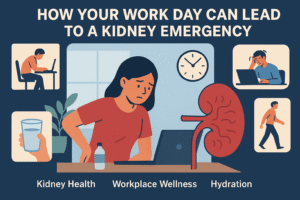It is one thing to have high blood pressure. It is another when that pressure quietly starts damaging your kidneys. The two are more connected than most people realize. At Southern Oklahoma Kidney Center, we see how hypertension and kidney disease often fuel each other, and why catching the link early can save both your kidneys and your life.
When Pressure Builds, Kidneys Suffer
Your kidneys depend on steady blood flow to do their job. High blood pressure — even if it does not cause symptoms — starts to wear down that system. Over time, blood vessels narrow, and kidney strain sets in.
Think of it like this: the more pressure behind a hose, the more likely it is to leak or break. Your kidneys’ tiny filters work the same way.
This kind of slow, silent damage leads to a gradual decline in kidney function. Many patients do not notice anything wrong until they lose significant function.
How the Cycle Turns Dangerous
It is not just one-way damage. Hypertension and kidney disease create a feedback loop. As kidneys weaken, they stop controlling fluid and salt properly. That imbalance causes blood pressure to rise — which then hurts the kidneys even more.
The cycle keeps spinning:
- Damaged kidneys raise blood pressure
- High pressure speeds up kidney decline
- The body loses control over both systems
Breaking this cycle takes more than just a pill. It takes strategy and support.
Warning Signs to Watch (Even If You Feel Fine)
High blood pressure rarely shouts. Neither does kidney trouble. But there are small signs that something may be off.
Pay attention to:
- Swelling in the ankles or around the eyes
- Fatigue you cannot explain
- Headaches that feel different
- Trouble sleeping or focusing
- Changes in how often you urinate
If you have more than one of these, it is time to check both your pressure and your kidney function.
You can always talk to our kidney specialists for guidance, even if you are not sure what is going on.
Managing Both Conditions Together
When we treat patients with both conditions, we do not separate them. Managing one helps the other. That is why your care plan will likely focus on:
- Blood pressure control with kidney-safe meds
- Low-sodium nutrition plans
- Fluid monitoring
- Regular kidney function testing
- Tracking weight and swelling daily
It is not just about lowering a number on a monitor. It is about preventing blood vessel damage and kidney decline from moving further.
Lifestyle Changes That Help
You do not need to change everything overnight. But steady changes matter.
Start here:
- Walk a little more each day
- Use herbs or spices instead of salt
- Check your pressure at home a few times a week
- Avoid NSAIDs unless approved by your doctor
- Drink water throughout the day (but not excessively)
These small shifts reduce high blood pressure risks and protect your kidneys in ways medications alone cannot.
You Can Get Ahead of This
If you already have high blood pressure, now is the time to check your kidneys. If you are living with kidney disease, your blood pressure should never be ignored. The two conditions walk hand in hand, and if you are not watching both, you are missing half the story.
At Southern Oklahoma Kidney Center, we help you look at the full picture and build a plan that keeps both systems working together, not against each other.




